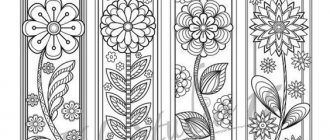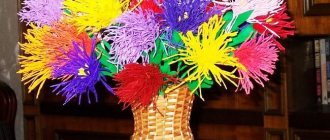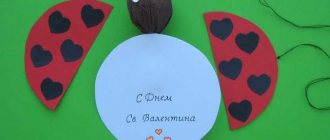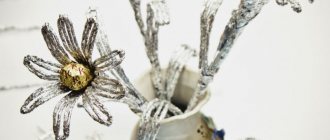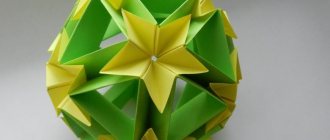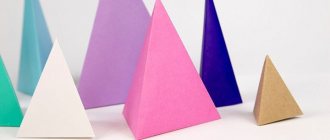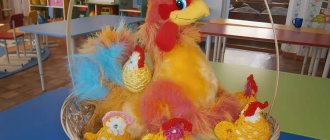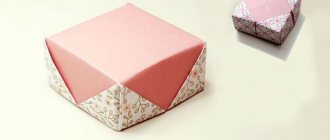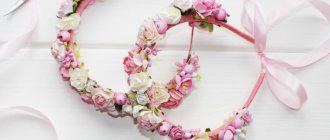We present to you a master class with step-by-step instructions and photos on how to make the most delicate paper hyacinths with your own hands. Making such a flower is not at all difficult; you only need double-sided colored paper, scissors, glue and a little free time, and step-by-step instructions with photos will help you do everything as correctly as possible.
Myths and prototypes
An ancient Greek mythological story is associated with hyacinth.
Hyacinth is a very handsome prince from Sparta, who was accidentally killed by Apollo during a joint game of discus throwing. Beautiful fragrant flowers sprouted from droplets of the dead young man's blood. In modern images we see hyacinths in white, blue, lilac, pink, purple, purple and even yellow. This is a bulbous plant with a thick, low peduncle. Small flowers, similar to stars with bent petals-rays, are tightly collected in a pyramidal vertical inflorescence. In general, the flower even seems curly. The stem is framed by two or more smooth, long and narrow leaves.
These features of a real plant are reflected in paper crafts.
What does hyacinth look like?
To understand how to make a beautiful hyacinth with your own hands from scrap materials, you should turn to the original. What are its most recognizable, characteristic features?
The plant is distinguished by many small flowers collected in an inflorescence-brush. Double varieties are now popular, but hyacinth was originally a fragile spring flower with simple and graceful bell-shaped flowers.
The petals are coquettishly bent. The leaves, like many bulbous plants, are simple, narrow and long, collected in a bunch around the stem. Hyacinths are bouquet flowers; they look best in masses; as a rule, they are grown in groups of 5-7 pieces.
Preparing for work
For work we need a very small set:
- Double-sided, medium-weight colored paper.
- Stationery scissors.
- Glue stick or PVA glue.
- Ruler 30 cm.
- Pencil or thick knitting needle.
The color of the paper can be arbitrary: one tone or different shades that combine with each other. For the stem and leaves you will need green paper, preferably in a grassy shade that is closest to the real one.
Manufacturing process
To get started, try making a simple hyacinth using our basic step-by-step master class.
Blanks
We cut the green paper into rectangles with sides 5-6 cm and 15-20 cm. These will be the stems. We will need as many blanks as the number of flowers we plan to make.
For the inflorescences, we will also need rectangles of double-sided colored paper - 5 by 20 cm.
Inflorescences
Along the long side of the rectangular blank, we bend the paper to a width of 1 cm. For convenience, especially if we are working with children, we can draw a thin line with a pencil along a ruler.
So, our rectangle is divided into two parts - 1 cm and 4 cm wide. We cut the 4 cm side across to the fold. We make a fringe with a side of no more than 1 cm. You can cut according to pencil markings, or you can do it by eye. This way the petals will look even more natural.
Petals
Now comes the most painstaking stage of the work: each piece of fringe needs to be twisted into a spiral. You can do this with your hands or use improvised materials - a pencil, a knitting needle, a wooden skewer. The more carefully this work is done, the better and neater the appearance of the hyacinth will be.
Stem
We twist the rectangle for the stem diagonally into a tube. We move from the corner, securing the ends of the paper with glue. Let the stem dry.
Leaves
We take green paper again and cut off a rectangle 5 cm wide. We take the length arbitrarily. On one of the wide sides we bend the edge 1 cm, as we did for the flowers. On the other, we cut out the cloves in the form of leaves.
Assembly
- We take a paper tape with prepared petals and begin to wrap it around the stem in a spiral, moving from top to bottom. We secure the upper edge with glue, placing the coils as closely as possible to each other so that the flower is lush.
- Now we also wrap the stem with a blank with leaves. We also secure the ends with glue.
- We bend the green leaves slightly outward and evenly trim the tip of the stem tube.
- We collect the rest of the flowers in the same way.
The bouquet is ready. All that remains is to choose a beautiful vase for it or place it in a pot of suitable size. The pot can be made from a cut plastic bottle. We decorate it with a beautiful piece of fabric or a piece of wrapping paper or cellophane.
Fill the inside of the container with crumpled paper and paper scraps. They can easily strengthen the stems of ready-made flowers.
Step-by-step instructions with photos
So, let's start creating flowers with our own hands.
Step 1: Cut Rectangles
So, take colored paper and cut it into rectangles measuring 5 x 20 cm.
Make a fold on the rectangle along the length of approximately 1-1.5 cm.
Step 2: Shape the Petals
Using scissors, cut the rectangle widthwise into thin strips 0.5-1 cm to the fold line that was made in the first step.
To save time, fold the rectangles in half.
Step 3: Make Flowers
- Having finished cutting the strips, you need to wrap the fringe into curls.
- To do this, use your fingers to twist each strip into a neat curl. This will take time, so be patient. The more carefully the work is done, the more beautiful the flower will turn out.
Step 4: Make the stem
- Roll the paper diagonally into a thin tube.
- Use glue to secure the beginning and end of the tube. Carefully trim the ends.
Step 5: Collect the flower
Apply glue to the free edge of the curled paper from the fold line.
Wrap the curl with glue applied around the green tube in the form of a spiral. Start gluing the curl from the top, gradually moving down to the bottom of the stem.
Step 6: Make the Leaves
To make the leaves, cut green paper into rectangles measuring 5 x 7.5 cm.
Fold the rectangle like an accordion with an edge of 1 cm.
Popular articles Volumetric imprint of palms and heels
Great DIY gift)
To make this craft we will need:
Colored crepe paper or colored paper napkins; - sheets of white and green paper (double-sided)
; - PVA glue; - a stick with a sharp end or a pencil; - narrow satin braid 40-50 cm long; - scissors.
Craft making process:
Make a pot out of a plastic bottle by cutting off its upper part by 2/3 with scissors. Then crumple up a sheet of paper and put it in the “pot” (you can also use newspaper for this purpose)
.
Using a pencil (stick)
, roll 1/2 of a sheet of paper into a tube, make cuts at the bottom and glue it to a lump of paper - this is the stem of a flower.
Cover the lower part of the stem with green paper (the tube can be rolled directly from green paper).
Cut colored crepe paper or napkins into squares. But it should be taken into account that to make a flower using the trimming technique, smaller squares are needed (2.5x2.5 cm or 3x3 cm)
.
And to make a flower from napkins crumpled into balls, use larger squares (4x4cm or 5x5cm)
.
Glue the flower stem starting from the top edge using the “trimming” technique. To do this, use the pointed end of a stick (pencil)
Place it to the center of the square blank and lift its edges upward, scrolling with your fingers. Then dip the lower tip of such a blank into PVA glue and glue it to the stem-tube.
You can first prepare blanks of hyacinth “flowers”, and then glue them to the tube (stem)
, after lubricating it with glue
(this method, in my opinion, is the fastest).
To make crafts using the “rolling napkins into balls” technique, you must first make ball blanks (crumple the square blank and roll it into a ball with your fingers).
Then carefully dip one side of each ball into glue and glue it onto the tube, starting from the top next to each other.
( Making a flower using this technique is the simplest, fastest, and the result is no worse).
Cut long, narrow leaves for hyacinth from green double-sided paper (4 leaves for each flower)
.
Welcome to my blog! Haven’t decided yet what craft to make for your mom or take to kindergarten for March 8th? No crepe paper or tired of origami? I suggest not to strain and make it incredibly spring-like and beautiful in 1, well, maximum - 5 minutes. And the second option is a lush hyacinth in a pot in 15 minutes.
Where hyacinth flower crafts come in handy
There are several simplest in meaning and idea options in which a plant element of this type can be used. A craft made from hyacinth flowers can be used:
- When preparing gifts for the holiday of March 8th.
- For making a homemade birthday gift for your grandmother, mother, sister.
- To create children's crafts for the "Spring Festival" in kindergarten or school.
- Hyacinth in a pot can be an excellent decor for an office or room.
If flowers are made using the appliqué technique, they can become the central element of the picture.
Volumetric flowers
If you want to achieve maximum effect and have enough patience, then try to simulate flowers that are practically indistinguishable from living plants in volume and texture. To do this, you need to follow the previous scheme, but make each bud separately. In each tier, the petals should not overlap each other. As a result, it will be possible to achieve the identity of the original.
In this case, it is best to use corrugated paper at the top of the craft, which is soft and flexible. It will produce truly graceful and fluffy flowers, or rather, in the florist’s language, double flowers.
Using any technique, thanks to simple hand actions, it is easy to create an original gift or souvenir for a good mood.
Required materials and tools
The set of tools for any manufacturing method is the same, but the materials may differ. What types of materials can be used:
- Most often, hyacinth is made from corrugated paper. The texture of the material gives the petals lightness and naturalness compared to ordinary colored paper. At the same time, working with such material is not at all difficult.
- To make children's crafts, it is best to use double-sided colored paper. This type of material is more durable than corrugated paper.
- Wire, a wooden skewer, a cocktail tube, or a paper tube can be used as a stem. To finish the first 2 types of warping, green electrical tape, satin ribbons, and green paper can be used.
Much depends on the type of composition. The flower can be placed in a decorative vase, “planted” in a pot, glued to a cardboard sheet, attached to a fabric base, or placed in a box.
To work on a flower you need to prepare scissors, glue, a ruler and a simple pencil. In rare cases, sewing threads or double-sided tape are used for high-quality fastening.
Making petals from crepe
Corrugated paper is a very popular material for craftsmen. Thanks to the beautiful designs and realistic models of flower bouquets, crepe has become widespread.
Step-by-step description of the work:
- To work, you will need to cut a strip of crepe more than 55 cm long and 12 cm wide.
- Cuts of approximately 5-6mm are made along the entire length of the paper blank.
- For further work, you need to prepare a wooden skewer or a thin round-shaped stick.
- Taking 3-5 strips at a time, roll the blanks into petals.
Each craftsman can change the size of the rings on a hyacinth branch by changing the width of the paper strips and the degree of curl of the fringes.
How to make hyacinth from paper rings on an oval base
What can a child give to his mother? Of course, a simple DIY craft, and it’s best if it’s a paper flower, since the availability of this material is obvious, and all mothers love flowers. Your child, independently or with a little help from an adult, will be able to make hyacinth from paper rings on an oval base according to the illustrated descriptions that this master class has. The finished flower craft - hyacinth will be a good gift for mom or will decorate a child’s room. So let's start making a flower - hyacinth.
To make a hyacinth flower, prepare:
- purple and green paper;
- scissors;
- glue;
- pencil.
Almost any child can handle this craft with minimal supervision from an adult. The only thing is that you will have to guide the baby, showing him the sequence of the process. First we need to make blanks for the future hyacinth flower, cut the prepared A4 sheets in half. As a result, we got two purple leaves and two green ones.
Draw an oval on one half of the purple paper. This will be the basis for the flower itself.
After this, cut out the drawn oval with scissors.
Fold the remaining half of the purple paper in half.
Cut a sheet of paper into two parts.
Now these purple paper sheets need to be cut into small strips (about 1.5-2 cm wide) for further making rings for the flower - hyacinth.
We twist each strip into a ring and secure it with glue.
We need to make quite a large number of such rings for the flower.
We begin to glue the rings onto the oval hyacinth blank prepared in advance.
In this way we fill the entire surface of the paper oval of the flower.
Now you can start making the stem and leaves of our hyacinth. To create a stem, we begin to fold half a sheet of green paper prepared in advance into a narrow strip.
We grease the edges of the strip with glue, and as a result we get a green stem.
We glue the finished flower stem to the back of our hyacinth.
Fold the other half of the green paper into 4 folds.
From it we cut out the following type of workpiece.
This is how we got 2 green leaves for the hyacinth flower.
We glue them at the bottom of our flower.
Thus, we managed to make a hyacinth from paper rings glued onto an oval base with green leaves and a stem.
This is what our paper hyacinth looks like when the craft is completed.
Step-by-step assembly of a bouquet of flowers
Paper flowers of this type are often collected in bouquets to form a complete composition. Initially, you need to make several branches of flowers. For this, one of the presented techniques can be used.
Next, we make paper hyacinths to form a bouquet:
- When the flower branches are ready, you should start decorating the leaves.
- Cut a rectangle whose height will correspond to half the height of the stem.
- Fold the workpiece like an accordion. The smaller the accordion, the better for the formation of leaves.
- Having assembled the accordion, you need to cut off the edges, sharpening them a little. Then unfold the workpiece.
- Lubricate the stem with glue and gradually wrap the strip with leaves. In this case, each subsequent turn on the stem must be coated with glue again.
Step-by-step photo for finishing a hyacinth stem for a bouquet.
The resulting branches can be wrapped in gift or transparent paper according to the same principle as bouquets of fresh flowers. The bases should be tied with tape. The souvenir is ready for donation.
Varieties of crafts with assembly diagrams
To form blooming arrows of hyacinths, it is worth using a master class suitable for the composition with a detailed algorithm. Thanks to some types of schemes, you can create a flower with a natural shape and type of buds. In each case, everything is described in more detail in step-by-step diagrams.
Origami with diagram
The easiest way is to make a hyacinth sprig from colored paper. This manufacturing principle is referred to as the origami technique. Even a small child can cope with such a task, since the assembly process is represented by a complex of elementary actions:
- Cut a sheet of A4 colored paper into 2 equal parts along the length of the side.
- Fold a 1 cm wide strip along the larger side.
- Divide the entire length into equal narrow strips. Cut the workpiece into divisions until the longitudinal strip bends.
- Using scissors, twist the resulting strips in one direction.
- Prepare a 0.5 cm wide strip of green paper. Grease a long wooden skewer with glue and screw the strip onto the base.
- Then wind the flower blank in tiers according to the same principle as the green part.
- Make leaves by folding the rectangle like an accordion and cutting off the tops. Then glue the workpiece to the base.
By preparing several elements, you can create a beautiful bouquet of spring flowers.
Video master class in quilling technique
A simple example of applique using the quilling technique
Applications for children
For children, the best technique is appliqué. This also applies to crafts in which hyacinths occupy a central place. In kindergarten or elementary school, children can be offered this option for making an applique:
- Cut out an oblong oval from colored paper. Glue the blank onto a sheet of cardboard.
- Make a striped stem and teardrop-shaped leaves from green paper.
- Glue these parts at the base of the oval.
- Prepare many strips 4-5 mm wide and 2-3 cm long. Glue each strip in the form of a ring.
- Place all the rings around the perimeter of the oval in any order.
The main advantage of this craft is that all the elements are completely simple, and the result is a voluminous applique.
Using paper napkins
What do we need for this?
- green paper;
- several napkins;
- pencil or any similar object;
- scissors;
- glue stick;
- a little foam rubber of a dark shade;
- a flower pot or an unnecessary glass.
Let's get started:
We cut a sheet of green paper in half, set aside one part, roll the second into a tube using a pencil, and then take it out. Apply glue to the edge of the paper and glue the tube. Thus, we made a stem for our hyacinth.
We take our napkins, but do not unfold them, and cut them into nine equal squares. Our squares turned out to be multi-layered, so we cut them so that each square has one layer.
We take one resulting square and place a pencil in the middle with the opposite end, lift the edges of the napkin with our fingers and press them to the pencil.
Hold the edges of the napkin with your fingers and apply glue in the middle. Pay attention to the photos, they will help you not get confused and do the craft correctly.
Without removing the pencil, we cover one of the holes in our stem with this square of napkin. Now remove the pencil. Let's do the same thing, only now we'll seal the other hole in the stem.
Glue several pieces of napkin close to each other along the edge of the stem in order to make the first row. So you need to make as many rows as you see fit. It's a matter of taste here.
We still have one more piece of green paper left. We cut out several oblong strips from it; they will serve as leaves for the hyacinth.
Next, you need to apply glue to the bottom of our leaves and attach them to the stem from below.
Let's put the pre-prepared foam rubber in our pot, make a hole in the middle with scissors to put the resulting flower there.
Making paper hyacinth is not difficult. Be sure to try it!
Hyacinth made of multi-colored paper
Flowers made with your own hands from paper will decorate your home and add coziness.
What do we need for this?
- yellow and green paper;
- toothpick;
- office glue.
Let's get started:
Let's take yellow paper and cut out a 6x14 cm rectangle from it. Cut the green paper into 2 parts - a 6x15 cm rectangle and a 6x6 cm square. The yellow paper will be our flowers, and the green paper will be stems and leaves.
Decorating the bouquet
Having made several branches of hyacinth, you should give them the shape of an original bouquet.
At the request of the master, you can decorate the petals and stem with a scattering of rhinestones, and wrap each branch with a decorative net or ribbon.
The bouquet itself is assembled, wrapped in illustrated paper and tied with a satin ribbon. A chic and original bouquet will be appreciated by any birthday person.
Corrugated paper hyacinth
What do we need for this?
- colored corrugated paper;
- green and white paper;
- office glue;
- pencil;
- a narrow satin ribbon no more than half a meter long;
- scissors;
Let's get started:
Let's make a pot from a plastic bottle. We crumple a sheet of paper and put it into the resulting pot.
We take half a sheet of paper and, using a pencil, twist it into a kind of tube, and cut it at the bottom and glue it to a lump of paper - this will be a hyacinth stem.
Master classes on creating hyacinth
The entire process of creating a decorative flower bouquet can be divided into several stages:
- Making petals.
- Making the base stem.
- Assembling a finished hyacinth branch.
The work is completed by arranging the bouquet (packaging in paper, an original basket or mesh structure) and decorating the flowers. Despite the generality of work, there are some differences depending on the chosen technique.
Blanks using the trimming method
Multi-layer napkins or paper towels are ideal for trimming. You can also use crepe paper.
- We fold paper napkins several times and cut them into small squares with a side of 2-3 cm. It is not necessary to do this very evenly and achieve absolute uniformity.
- We take such a piece, place the tip of a pencil or skewer in the center, bend the corners of the paper towards the stick, and twist it a little.
- Then lightly dip the tip with the paper into glue and attach it to the base.
- So step by step we fill the entire space of the cylinder. The closer you place the elements to each other, the more natural and voluminous the flower will turn out.
The cutting method is easy to make planar and three-dimensional applications with young children. The technique develops motor skills, spatial and figurative thinking.
Sources
- https://mld-mobile.ru/iz-bumagi/giacinty-svoimi-rukami-iz.html
- https://HobbyLaby.ru/raznoe/giacint-iz-bumagi.html
- https://e-ipar.ru/cvety-iz-bumagi/giatsint
- https://topotushky.ru/svoimi-rukami/giacint-iz-bumagi-vidy-origami-i-osobennosti-sozdaniya-cvetkov.html
[collapse]
